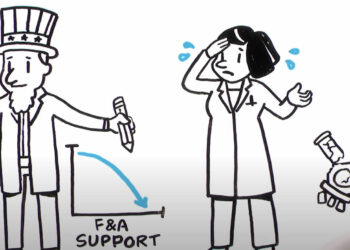 This month we’re asking the Chefs about customer focus. The question was inspired by a comment that Rick Anderson posted in August in which he wondered if the enhancements and features publishers implement are truly focused on customer needs. Seeing all of the Chefs’ responses, and having opinions of my own, I find it very interesting that almost everyone, in one manner or another, took a step back and pondered: Who are the customers? As markets shift, as technology advances, as business strategies evolve, how do we identify our customers, understand their needs, and create (alone or with partners) the products and services they will find valuable?
This month we’re asking the Chefs about customer focus. The question was inspired by a comment that Rick Anderson posted in August in which he wondered if the enhancements and features publishers implement are truly focused on customer needs. Seeing all of the Chefs’ responses, and having opinions of my own, I find it very interesting that almost everyone, in one manner or another, took a step back and pondered: Who are the customers? As markets shift, as technology advances, as business strategies evolve, how do we identify our customers, understand their needs, and create (alone or with partners) the products and services they will find valuable?
I do hope that you too will offer your views in the comments. After all, variety is what spices up everything prepared in this Kitchen!
Our question this month: Are publishers customer focused? What drives the development of new products and features?
Joe Esposito: Publishers are and are not customer-focused. It depends on what you mean by a customer, and it depends on what timeline you are referring to: today’s customers or those a publisher hopes to entice in the future. For most scholarly publishers the customers are institutional, which means that decisions are made for users by third parties. Those institutional purchasers impose their own set of requirements, and features are built to satisfy them. Just about no one in scholarly publishing is paying for things with his or her own money (which would make this into consumer publishing). This drives up costs and introduces feature sets that may not be necessary from a user’s point of view. Libraries are very expensive customers.
BTW, being customer-focused is not necessarily a good thing. Apple famously is the opposite of that. A customer focus is typical for industries in their mature stage. Innovators, on the other hand, have to invent their customers.
David Crotty: The quick answer here is that it depends on the publisher, and likely it even varies quite a bit journal to journal within a publishing house. There are many different pathways to product development (if you’re not reading Steve Sinofsky’s blog on the subject, you should be), and while it’s vital to listen to and be aware of your customer’s needs, they can’t be depended upon to drive actual innovation and development–that’s your job. Most publishers do spend a great deal of time and effort observing what readers and authors do, as well as what they say (through things like usability testing and focus groups). A great deal of journal development is done this way. But, as famously said by Steve Jobs:
It’s really hard to design products by focus groups. A lot of times, people don’t know what they want until you show it to them.
Because of the intense competition for research society business, publishers are very keen on differentiating themselves. So, despite frequent low value and low uptake, a lot of pointless features and technologies do see the light of day on various platforms. Things then snowball as no publisher wants to look behind the times when compared to rivals in the bidding process, so poor technologies spread as a result of keeping up with the Joneses. This is often why publisher seem tone deaf to researcher needs, offering things that nobody wants or uses. Those publishers are indeed customer focused, but their customers are the societies whose business they’re trying to win, not the actual readers or authors of the journals.
Michael Clarke: The challenge in talking about customer-focus is that publishers have many sorts of customers. To further complicate matters, the same customers have different information needs and behaviors at different times. A physician, for example, might at one point be conducting a literature search related to a case. At another point, the same person might be reading for current awareness. At yet another point, she might need to quickly look up specific diagnostic or treatment information (increasingly on mobile device, and often not while on an institutional network). At still another point, she might be conducting research in preparation for submitting a manuscript.
Publishers focus on certain customers more than others, usually because that customer segment is more important to that particular publisher’s business. Nonetheless, publishers must, to some extent, balance the needs of these diverse, and often conflicting, customers. It is interesting to watch points at which shifts in customer focus occur. This happened over the last decade with regard to professional associations and library customers. Associations have historically had laser-like focus on their members and did not have much interaction with libraries at all, working instead through intermediary subscription agents (who often did not share with publishers who their library customers even were). With the advent of site licensing, professional associations began selling directly to libraries and, as a result, have become more cognizant of library needs. Another shift is occurring right now with respect to authors. Authors, of course, have always been important constituents for publishers but for publishers with gold OA titles, they are now important paying customers. This shift is resulting in the development of new authors services and metrics, efforts to further reduce publication schedules, and efforts to reduce points of friction in the submission process for journals.
Rick Anderson: The short answer, inevitably, is “some are, some aren’t.” But in this case the question is complicated by the ambiguity of the term “customer” in the context of scholarly publishing. If by “customer” you mean “the person who buys the books and pays the subscription fees,” then you’re talking about academic libraries and individual paying readers. If by “customers” you mean the people who consume the information produced and sold, then you’re talking about readers, many of whom are not themselves paying customers but rather beneficiaries of institutional sponsorship of some kind. Of course, by “customers” you might also mean the authors to whom publishers are “selling” their publishing services (by which I mean providing those services in return for copyrights or licenses to publish).
So are publishers customer-focused? Sure, but they’re not equally focused on the needs of all the entities that could reasonably be called “customers.” In fact, my experience suggests that publishers’ focus on those who might be called customers is tiered: authors first; readers second; libraries third. This tiering reflects the differing levels of competition that publishers face in the various marketplaces in which they function. Publishers have to compete hard with each other for authors, because the service any particular publisher offers to authors in return for publishing rights is not very unique. The content that a particular publisher offers to readers and libraries, however, is unique, which means that one publisher does not compete with others for readers in the same way that it competes with others for authors.
Jill O’Neill: I have never met a publisher who didn’t believe s/he was customer-focused. The caveat, of course, is determining who the publisher believes the customer to be.
- Is it the institutional library bearing the responsibility of acquiring or licensing the product?
- Or is it the individual researcher who may be the actual user of the product/service?
- Or is the customer a broader population of researchers whose common disciplinary workflow represents the opportunity for product development and expansion?
It doesn’t do to engineer the perfect product, only to be told that the librarian can’t afford the cost increase that may be incurred by that level of engineering. It doesn’t do to frustrate the work of researchers by delaying or restricting product enhancements to only those that won’t significantly increase internal costs. Finally, it doesn’t do to pretend that the entrenched expectations of the ranking echelon of scholars is the only set worthy of note. Intelligent innovation should, can and does emerge from meeting the needs and expectations from those lower on the ladder.
The responsible publisher recognizes that the needs of all of the above “customers” must be factored into product development processes. Market surveys, advisory boards and user consultation should always drive the introduction of enhanced features to a product. The challenge for publishers is communicating honestly to the various “customers” the explanation of why a specific need/demand was not the primary consideration in this particular iteration of a product.
Robert Harington: When faced with a question such as this, a publisher’s natural response is perhaps at first defensive. “Of course we are. Have you seen all the exciting new offerings we have?” As any good therapist will tell you, address the reason for asking the question in the first place, and try not to be sucked into proving a point.
The reason why this question is important is that while publishers continue to do what they do best, publishing books, journals and a range of electronic products, the customer base is changing, both in who the customers are, their spending power and what the customers actually do. Here at the American Mathematical Society we serve the interests and needs of mathematicians. Mathematicians are thinkers, researchers, students, financiers etc. Customers are authors, readers, librarians, corporations, governments and so on. Those of us that have mature and successful products do indeed need to better understand customer needs – there is no question that we have products that need to be considered in light of changing customer requirements, not ignoring the ability of competitors to siphon off your core audience.
The drivers of development lie in a combination of a tuned organizational culture, and a willingness to think big and create vision in context of uncertainty. A publisher can think through a range of scenarios and outcomes, and understand where they may be able to play in the market. Understanding your publishing future means that you have a handle on the right combination of risk and caution, Caution is not an ugly word, and being first is not always where you want to be in line. New product development then is borne of culture and vision, but also out of analysis. You need data to inform your decisions. Data is both powerful and limiting. Being held ransom to data is not the way to go, but using data to understand how competitors work, and what has worked before given a range of variables is a powerful. Then there are the users themselves. How to you take the temperature of the user? Is it enough to hold casual focus groups, or is it necessary to wade in deeper, using techniques that agnostically monitor the way a customer behaves around content – techniques such as contextual enquiry.
In summary, innovative product development will derive from a rich blend of culture, vision, caution and user behavior studies.
David Smith: The question really is are we focusing on the right customers? Are we navigating the vast differences between they who pay the bills and those who use the stuff we produce or curate? Do we really have enough information to be able to benchmark whether we are serving our customers? Have we agreed who our customer base is (hint: if it’s ‘everybody’ then we aren’t really focusing on anything) and how to handle the others who come along who are NOT our customers?
We should be stratifying customers into groups according to the net value they bring into the product in question. This is what Google does, and Amazon and the other titans of the digital age. They version their information goods in sophisticated ways to maximize the potential revenue and they dynamically adjust (based on constant testing) where the optimal price points lie for a given tranche of customers. Hal Varian wrote a paper on it. It’s worth looking up. This is what drives the development of new features at Google and Amazon – how to lock in users and how to build moats around those users to stop them being poached, or wanting to go elsewhere. Someone is always asking two questions; 1) How might this item drive more input to our chosen business model and 2) Where is the data to support or refute that idea. And lucky them, they get to see the results of their tests, 24/7.
Oh that we could develop in the same way! But the horrible truth is that a subscription model paid for by one party and mostly used by another is hard to develop using that approach. Because the answer to “will this widget or feature drive increased revenue” is NO. Almost certainly not. You might well increase satisfaction, approval, time on site, depth of visit. You might increase usage, but guess what, unless the customer is threatening to walk away due to low usage, you won’t get more money that way. This is the difference between the necessary and the sufficient. And so we walk the tightrope between those who pay, and those who use. This last week, at a conference just outside Heathrow I heard the following requests for developments: No more whistles and bells, we are tired of paying for them; But we want more usage or we’ll cancel; We hate pdfs; Except when we don’t; We want to data mine however we want whenever we want; And connect the papers to the data (but without the whistles and bells?); We want CC:BY:0 (But the academics don’t really, they want the NC option). That’s quite a bucket of feedback ain’t it. Going to be a challenge to focus on all those customers!
Judy Luther: An observation made by Cliff Lynch at a Charleston Conference years ago distinguished between the initial period of transition of content to a new technology (first CD-ROMs, then the Internet) followed eventually by the transformation that delivers on the potential for innovation. The last decade saw most of the scholarly journals brought online to a standard that included DOIs, and COUNTER compliant usage data.
Within the last few years, we’ve seen changes to the structure of the journal webpage enabling the reader to navigate more easily to different elements. The norm includes tools for sharing a link to content and for saving the notes the reader might jot in the margin. The multitude of reading devices are further pushing requirements to enable a multitude of displays.
Many publishers cannot afford the risks associated with experimentation and must wait until their platform host can spread the cost over many titles. A few have what is required to explore new options and once these are deemed useful, those who don’t incorporate them are considered behind the curve.
Alice Meadows: There isn’t a simple answer to this question but I think it’s probably fair to say that historically books publishers have been more customer focused than journals publishers. For example, books publishers have for many years realized that authors are an important customer group, whereas journals publishers have only recently started to do so. And while books publishers have long been developing products such as textbooks in response to specific customer needs, journal publishers have until fairly recently tended to take more of an ‘if we publish it they will subscribe’ approach. Journal publishing is changing though – driven largely by the move to online and the expansion of open access, which have required us to rethink who our customers are and led to competition from organizations like Google who are much more customer-focused than us. The big question is whether we can change quickly enough to survive and thrive – I hope and believe we can!
Discussion
5 Thoughts on "Ask The Chefs: Are Publishers Customer Focused?"
Isn’t open access itself one of those innovations where advocates needed to convince an audience that this is something they really needed and could benefit from? Given what surveys have told us, that effort still has some way to go before it can declare victory.
As for Joe’s comment that the main market for scholarly publishers is institutional, I would agree so far as monographs and journals are concerned, but the regional publishing that many state-based university presses do is quite different in that respect. There the main audience is popular, and presses use many different techniques (including sales through non-book outlets like general stores) to reach it. Also, the main institutional target for those books is public rather than academic libraries, so it’s a different customer in that sector also.
A salient key in dealing with STM customers (libraries, researchers, authors, editors, readers) is being proactive (everyone in the publishing house must be proactive—a team); understanding the concerns and the constraints one’s customers deal with everyday; realizing STM publishing is an “ideas” milieu that has everything to do with the unique quality of ideas, and little to do with popularity; the “elephant in the room” is concurrent institutional budgetary constraints with no end in sight; and the nation (from top down) must return to “can do” ethos regarding scientific research and development (government & corporate) in lieu of “cannot do anything” because we can’t determine the ROI or the direct applicability of the research.
I see a theme in these responses — it’s not always clear who the customer is, especially with so many purchasing intermediaries (libraries, society membership allocations, aggregators, consortia, funders). As publishers, do we have a customer? Or is it our authors who have the customer, and we just try to create a financially sustainable way to help them align with their customers?
The other quote I love is from Henry Ford: “If I had asked people what they wanted, they would have said faster horses.”
There may be an interesting conceptual confusion at work here. On the one hand there is the concept family exemplified by mission, community, science, etc. On the other there is the family that includes market, customer, business model and so on. Each concept family is coherent and useful by itself but they do not combine well, in fact they probably conflict in fundamental ways.
This is not unusual in the realm of concepts. In fact whole philosophical problems are built around just such conceptual conflicts, because analytic philosophy is based on the notion of conceptual confusion. The point is that conceptual confusions are not confined to philosophical problems. Rather they are common in everyday life.



